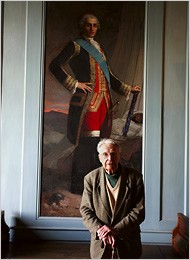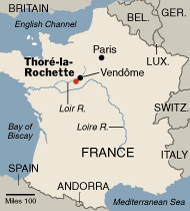"Remembering French Hero of the American Revolution"
By JOHN TAGLIABUE| With one minor editorial change, the text and images in this webpage are from an article written by JOHN TAGLIABUE published in the New York Times, June 15, 2007, Friday; Foreign Desk, Late Edition - Final, Section A, Page 4. |

| Michel de Rochambeau at home in Vendôme with a portrait of his forebear Jean Baptiste Donatien de Vimeur, who fought with George Washington at Yorktown and had a chateau at Thoré-la-Rochette. |
|
– THORÉ-LA-ROCHETTE, France — Michel de Rochambeau likes to think that the life span of a tree separates him from his most illustrious ancestor.
He recently had dozens of young lime trees planted in a row along the two-mile road that winds along the Loir River leading to his modest chateau in northern France. They replaced trees that had been planted by Jean Baptiste Donatien de Vimeur, Count of Rochambeau, the French military strategist and fellow-in-arms of George Washington at the Battle of Yorktown.
“Some simply died,” the present Count of Rochambeau said, warming to his story. “Others had been thrown down by storms. Those I replaced had been planted by the Maréchal.”
Being the direct descendant of Rochambeau, known hereabout as the Maréchal, for the title ..... that was bestowed on him by Louis XVI ......[see editorial note at end of article], would be almost a full-time occupation. But the count has supplemented it with the role of a kind of representative of trans-Atlantic relations, which he and his wife, Madeleine, have taken particularly to heart in recent years, when ties between Washington and Paris have been strained. (Those relations have been getting better. And some hope that the recent election of the moderately pro-American Nicolas Sarkozy as president of France may further improve them.)
Whatever the differences, they are not preventing the count and his family from playing host this summer to a Rochambeau festival to celebrate the 200th anniversary of the Maréchal’s death in 1807 — marked by small French and American flags along roads leading to the chateau — with conferences, lectures and 18th-century cultural events, including a production of Mozart’s “The Magic Flute,” in the chateau courtyard.
“The circumstances of the American Revolution merit being understood by the French,” said Darien Basset-Geraghty, an American neighbor of the Rochambeaus’ who is the director of the festival. “The formation of our country is complicated,” she said. “Rochambeau himself noted how the colonists, while casting off the English crown, kept their slaves.”
The count was born 90 years ago in Paris, where his father, an officer in the French Army, had gone for his career, leaving the chateau and its upkeep to a brother, who died in 1919, but whose widow stayed on until her death in 1949. The count’s aunt had little means to maintain the chateau, just outside the quaint village where Rochambeau is buried, especially during World War II, when German officers were for a time billeted in its rooms. (They left because it lacked central heating, the count said with a chuckle. He recalled once surprising a circle of Germans in an upper room, huddled around a ring of candles to keep warm.)
The original chateau was built in the 16th century. “It was a small Renaissance chateau,” the count said, seated in a former dining room, decorated with wall paintings representing the hunt, a family pastime. “The Maréchal enlarged it by the addition of two wings.” One now houses the count and his wife, the other a daughter and her family. (Central heat was added in the 1950s.)
The Maréchal typically kept a home in Paris to be nearer the royal court at Versailles. He was a settled veteran of 55 when in 1780 the king asked him to lead an expeditionary force of 5,500 men to North America to support the colonists in their uprising against the British king. The French, who had only a few years earlier lost most of their colonies in North America to the British, and a few years hence would lose their king to the guillotine, apparently reasoned that the enemy of their enemy should be their friend.
After the defeat of Lord Cornwallis at Yorktown, where the French soldiers under Rochambeau played a crucial role, he returned home a hero. But France’s own revolution in 1789, and its subsequent Reign of Terror, almost ensnared him.
“He was imprisoned at the Conciergerie in Paris, and put on trial,” the count said. “They had nothing against him. He was not a politician.” Nonetheless, he was condemned to die, but as he was led on to the charrette, the cart that carried the condemned to the guillotine, the executioner ordered him back, saying there was no room. By a stroke of luck, the terror effectively ended the next day, as Robespierre and his compatriots were driven from power, and Rochambeau was released to return unharmed to his property on the Loir.
The count shows visitors his ancestor’s bedroom, pointing out the armchair in which, in May 1807, at age 83, he was found dead, holding his newspaper; and the library, with many of his books and the slender desk in front of two tall windows, where he corresponded, with Washington, but also with the vanquished Cornwallis, whom he had visited on a trip to England in 1787. The count’s grandfather sold most of Rochambeau’s correspondence to the United States Library of Congress, he said, to help pay to maintain the chateau.
The count spent much of his youth in Paris, as an engineer after finishing his studies there, but his true passion remained the ancestral chateau. These days, he said, he takes frequent walks, leaning on his cane, around the four acres of grounds, reads or naps.
The count and his wife have invested their lives in the chateau. “Right after the war, it was in very bad shape,” he said. “There were no workers, no materials.”
His wife added, “When we were younger, we worked hard.”
Had they ever noticed the ghost of the Maréchal wandering the house or the grounds? The count threw back his head of white hair and let out a laugh. “I’ve never seen him,” he said.
* This editorial note has been added by webpage monitor to clarify dates of changes in Rochambeau's rank and distinctions.
|
* This editorial note extracts the sad news reported in a 28 December 2007 e-mail from Mme. Nocole Yancey (Honary Counsul of France for VA and Sec. W3R-US):
"I am very sad to inform you of the death of my very close friend MICHEL DE ROCHAMBEAU He passed away last night [27 December 2007]; memories of him are numerous and wonderful. As you all know, he was extremely involved in giving his ancestor his right place in history and thanks to his kindness and thoughtfulness, we were blessed in Yorktown with exhibiting many memorabilia. He and his dear Madeleine were very generous in opening the family estate at Thoré-la-Rochette, to all. I am so happy that Serge, Jacques Bossiere and I were able to make the trip to Vendôme last June and lay wreaths --- one for W3R-USA, the other for Souvenir Français --- at the grave of the Marshall in the presence of Michel, his son Guy, his daughter Nathathalie and officials from Vendôme and Thoré. I could tell you many anecdotes about this great gentleman who I was privileged to call my friend." |
| Jean Baptiste Donatien de Vimeur, comte de Rochambeau.. |
